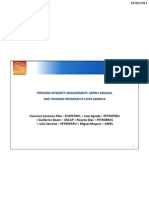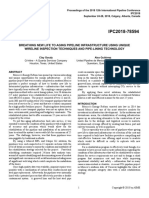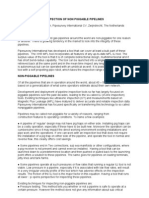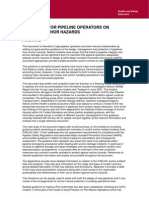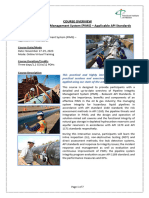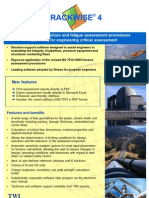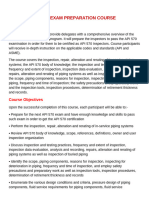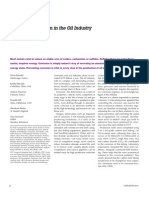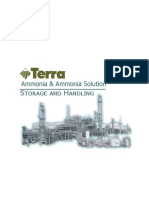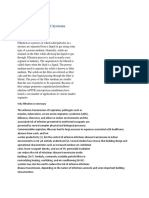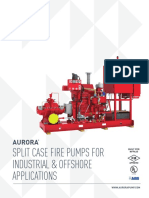Risk-Based Pipeline Integrity Management Course
Risk-Based Pipeline Integrity Management Course
Uploaded by
mah_abdelaalCopyright:
Available Formats
Risk-Based Pipeline Integrity Management Course
Risk-Based Pipeline Integrity Management Course
Uploaded by
mah_abdelaalOriginal Description:
Copyright
Available Formats
Share this document
Did you find this document useful?
Is this content inappropriate?
Copyright:
Available Formats
Risk-Based Pipeline Integrity Management Course
Risk-Based Pipeline Integrity Management Course
Uploaded by
mah_abdelaalCopyright:
Available Formats
Risk-Based Pipeline Integrity Management
Course Title: Risk-Based Pipeline Integrity Management
Duration: 3 Days
Course Description:
Pipeline integrity management is part of maintenance activities required to successfully operate a pipeline
over its designed life. This course will give attendance in-depth understanding of the engineering principles
behind this concept.
The attendees will receive a certificate from Z-Subsea by completion of the training course.
This training course helps to gain understanding on:
Overview of integrity management codes and standards
Identification of pipeline typical threats/failures
Definition of Pipeline Integrity Management systems
Assessment and management of Risk (Quantitative and Qualitative)
Pipeline Inspection techniques
Pipeline monitoring techniques
Integrity assessment to BS7910, DNV OS-F101 and API 579-1/ASME-FFS-1
Direct assessment techniques (Internal/External)
Reinforce learning using case studies and worked examples
Who should attend?
Integrity engineers
Safety engineers
Material Corrosion engineers
Pipeline engineers;
Subsea and offshore engineers;
Project engineers and managers;
Engineers from other sectors of the Oil and Gas industry who wish to gain understanding of
pipeline integrity management.
Risk-Based Pipeline Integrity Management
Course Contents:
Overview of Integrity Management
Codes and Standards
ASME B31.8S "Managing System Integrity
of Gas Pipelines"
API standard 1160 "Managing System
Integrity for Hazardous Liquid pipelines"
DNV RP-F116 Integrity Management Of
Submarine Pipeline Systems
NACE Recommended Practice 102
Inspection of pipelines
Energy Institute Guidelines for the
management of integrity of subsea facilities
Threat/Anomaly identification
Manufacturing related anomalies
Lamination
Lamellar tearing
Cracking
Geometrical anomalies
Fabrication related anomalies
Cracking
Misalignment
Welding related defects
In-service (operation) related anomalies:
Corrosion (internal, external)
Corrosion of welds
Third party damages
Cracking
High temperature damage
1. Pipeline statistics, facts and figures
Pipeline incidents in the North Sea and Gulf
of Mexico (GOM)
Summary of the failure modes
2. Pipeline Integrity Management (PIM)
Systems
Company and individual policy
Management of change in operation
(service)
Operational controls
Contingency (reserve) plans
Reporting/Audit and review
Information management (archiving)
3. Risk Assessment
Benefit of Risk assessment
Approaches in various codes
UK - IGE/TD/1 Edition 4, PSR (1996),
PD8010
USA - API 1160, ASME B31.8, 49CFR
192&195, API 571/580/581
Canada - CSA Z 662-99
Australia HB 105 (1998)
Risk modelling
Level 1 Qualitative Risk Ranking
Level 2 Semi-quantitative Assessment
Level 3 Quantitative Assessment
Risk analysis/control
Risk-based inspection (RBI)
Risk Based Inspection Tools
API RBI (API)
Riskwise (TWI)
Safeti (DNV)
4. Pipeline inspection and testing
Preparation for inspection
Inspection procedure
preparation/approval
Selection and qualification of personnel
Inspection history review
Inspection techniques
Inspection techniques:
API Standard 1163: In Line Inspection
Systems
Key terms and definitions
Types of tools
Reporting requirements
Performing the inspections
Hydrostatic pressure testing
Shut-in testing
Gas/media testing
Reporting
Risk-Based Pipeline Integrity Management
5. Pipeline Monitoring
Internal and external monitoring systems
for oil and gas pipelines
Flow monitoring and leak detection
Internal/External monitoring and leak
detection for Liquid Pipelines
Internal/External monitoring and leak
detection for Gas pipelines
Corrosion control system monitoring
Monitoring probes
Sonar and magnetic monitoring
technologies
Fibre optic sensing
Current and vibration monitoring
6. Integrity Assessments
Overview of available procedures for
performing integrity assessments
Gathering, reviewing and integrating data
Overview of integrity assessment
procedures to:
BS7910/DNV OS-F101 (Appendix A)
Assessment of crack-like defects under
static and dynamic loading
API579-1/ASME FFS-1 (Assessment of
metal loss (corrosion), Assessment of
dents/gouges
DNV RP-F101 (assessment of corroded
pipelines
ASME B31G or modified B31G
(RSTRENG)
Direct assessment according to NACE
ECDA (External Corrosion Direct
Assessment
ICDA (Internal Corrosion Direct
Assessment)
Corrosion Modelling Tools
de-Waard
NORSOK
Freecorp (Ohio Univ.)
Cassandra (BP)
Hydrocor (SHELL)
CORPLUS (Total)
7. Mitigation, Intervention and Repair
Mitigation planning
Key drivers
Selection of the technique
Mitigation methods
Intervention planning
Key drivers
Selection of the technique
Intervention techniques
Repair planning
Key drivers
Selection of the technique
Repair techniques
Weld metal deposition
Welded sleeves
Mechanical clamping
Coating repair
Pipe section replacement
You might also like
- Chapter 6 Risk Assessment 4 PipelinesDocument21 pagesChapter 6 Risk Assessment 4 PipelinesMAT-LIONNo ratings yet
- Chapter 5Document4 pagesChapter 5Marco Luigi100% (1)
- ItpmDocument14 pagesItpmsbasualdomontesNo ratings yet
- Calculation Result For 194-T-110 - 2Document21 pagesCalculation Result For 194-T-110 - 2RizkiNo ratings yet
- Storage and Handling of Anhydrous AmmoniaDocument39 pagesStorage and Handling of Anhydrous Ammoniamah_abdelaal100% (1)
- Storage and Handling of Anhydrous Ammonia - OSHADocument18 pagesStorage and Handling of Anhydrous Ammonia - OSHAmah_abdelaalNo ratings yet
- Recommended Readings For NACE ExamsDocument5 pagesRecommended Readings For NACE Examsmah_abdelaal67% (3)
- CAT M316D MaintenanceDocument66 pagesCAT M316D MaintenanceHenwy Dickinson75% (4)
- Lean Lexicon (Compiled by LEI)Document136 pagesLean Lexicon (Compiled by LEI)Antonio Cervantes100% (2)
- Forge Tech Avoiding Tank DowntimeDocument86 pagesForge Tech Avoiding Tank DowntimeDavid RodriguesNo ratings yet
- Asset Integrity MGMT AicheDocument18 pagesAsset Integrity MGMT AichejulianovilarsampaioNo ratings yet
- Five Fatal Flaws in API 581Document12 pagesFive Fatal Flaws in API 581Geert Henk WijnantsNo ratings yet
- A Semi-Quantitative Pipeline Risk Assessment Tool For Piggable and Un-Piggable PipelinesDocument12 pagesA Semi-Quantitative Pipeline Risk Assessment Tool For Piggable and Un-Piggable PipelinesgeeawhizNo ratings yet
- Process Capability BaselineDocument19 pagesProcess Capability BaselinecamilaskishoreNo ratings yet
- Sample Corrosion Verfication Report - FinalDocument9 pagesSample Corrosion Verfication Report - FinalRaja HoneNo ratings yet
- Pipeline Integrity Manual - PetroperuDocument15 pagesPipeline Integrity Manual - PetroperuvaldivijNo ratings yet
- 2018 ASME International Pipeline Conference - Breathing New Life To Aging Pipeline InfrastructureDocument9 pages2018 ASME International Pipeline Conference - Breathing New Life To Aging Pipeline InfrastructureAlex GutierrezNo ratings yet
- Pipeline Integrity Solutions LTR Rev.06 18 WebDocument6 pagesPipeline Integrity Solutions LTR Rev.06 18 WebSabbirHasanNo ratings yet
- Nace RP 0102: Ili: ApplicabilityDocument1 pageNace RP 0102: Ili: ApplicabilityAbir Ben DjemaaNo ratings yet
- Validating ILI Run With and Without Data Loss PDFDocument11 pagesValidating ILI Run With and Without Data Loss PDFMubeenNo ratings yet
- Inspection of Non Piggable PipelinesDocument3 pagesInspection of Non Piggable Pipelinessatishchemeng100% (1)
- RP G103 2007Document82 pagesRP G103 2007Robert SmallwoodNo ratings yet
- Risk Based Inspections (RBI)Document13 pagesRisk Based Inspections (RBI)Richard Koehler100% (1)
- Pipeline Anchor HazardsDocument14 pagesPipeline Anchor HazardsMohamed SamirNo ratings yet
- Risk Based Inspection Best Practice-The Technical Specification Ron Selva PP Simtech Keynote Paper-1 13th Icpvt 2012 LondonDocument20 pagesRisk Based Inspection Best Practice-The Technical Specification Ron Selva PP Simtech Keynote Paper-1 13th Icpvt 2012 LondonRichard KoehlerNo ratings yet
- Pipeline Integrity Presentation 10-03-2011Document22 pagesPipeline Integrity Presentation 10-03-2011Sanane100% (1)
- Pipeline Integrity Management System PIMSDocument7 pagesPipeline Integrity Management System PIMSSalik Ali SyedNo ratings yet
- Automation of Fracture and Fatigue Assessment Procedures (BS 7910) For Engineering Critical AssessmentDocument2 pagesAutomation of Fracture and Fatigue Assessment Procedures (BS 7910) For Engineering Critical AssessmentbkchoiNo ratings yet
- 2010-08-24 Pipeline Integrity Management GuidleineDocument22 pages2010-08-24 Pipeline Integrity Management GuidleineSate Joglo Tresno100% (1)
- Procedures For Inspection and Assessment of Fixed Timber DocksDocument75 pagesProcedures For Inspection and Assessment of Fixed Timber DocksstillifeNo ratings yet
- A Pipeline Integrity Management StrategyDocument10 pagesA Pipeline Integrity Management StrategycristianoclemNo ratings yet
- Introduction To CorrosionDocument8 pagesIntroduction To Corrosion이선엽No ratings yet
- Process Control WWTP3Document44 pagesProcess Control WWTP3Arima KouseiNo ratings yet
- XIV Paper 38Document11 pagesXIV Paper 38Zenon KociubaNo ratings yet
- AEA-HOIS (94) P2 Safety Valves InspectionDocument50 pagesAEA-HOIS (94) P2 Safety Valves InspectionHernán DazaNo ratings yet
- Reinforced Thermoplastic PDFDocument42 pagesReinforced Thermoplastic PDFShiblee Khalid AhmodNo ratings yet
- Maintenance and Inspection ProceduresDocument24 pagesMaintenance and Inspection ProceduresNIKHILNo ratings yet
- Mitigation of Internal Corrosion in Carbon Steel Gas Pipeline SystemsDocument24 pagesMitigation of Internal Corrosion in Carbon Steel Gas Pipeline Systemsakshat agrawalNo ratings yet
- Storage Tank Inspection PDFDocument2 pagesStorage Tank Inspection PDFtyo wibowoNo ratings yet
- FitnessForService PDFDocument19 pagesFitnessForService PDFJai Patel100% (3)
- AB-505 Risk Based Inspection Programs For Pressure EquipmentDocument23 pagesAB-505 Risk Based Inspection Programs For Pressure Equipmentjeswin100% (1)
- Latest Advances in RBI - Session 3Document20 pagesLatest Advances in RBI - Session 3Ahmed Abd ElmegeedNo ratings yet
- Asset Integrity Management System (AIMS) Well IntegrityDocument23 pagesAsset Integrity Management System (AIMS) Well IntegrityMohd RezalNo ratings yet
- Pipeline Direct AssessmentDocument29 pagesPipeline Direct Assessment김원재100% (1)
- DNV Risk Based InspectionDocument17 pagesDNV Risk Based InspectionMahmoud RefaatNo ratings yet
- Prosedur Onshore Pipeline Risk Assesment PDFDocument36 pagesProsedur Onshore Pipeline Risk Assesment PDFRonniNo ratings yet
- Saudi Aramco Inspection Checklist: Review Procedure - Post Test Reinstatement & Checklist SAIC-A-2006 30-Apr-13 PipingDocument15 pagesSaudi Aramco Inspection Checklist: Review Procedure - Post Test Reinstatement & Checklist SAIC-A-2006 30-Apr-13 Pipingpookkoya thangalNo ratings yet
- Structural Integrity Management Cranfield UniversityDocument4 pagesStructural Integrity Management Cranfield UniversityAndreasNo ratings yet
- SAIC-A-2005 Rev 8Document4 pagesSAIC-A-2005 Rev 8Syed ImranNo ratings yet
- OIL - AE - ICDA - PrA - Report - Line#26 - 02 - FINALDocument26 pagesOIL - AE - ICDA - PrA - Report - Line#26 - 02 - FINALPedro MarquezNo ratings yet
- POF 302 ILI Checklists - Nov 2021Document11 pagesPOF 302 ILI Checklists - Nov 2021Satya RaoNo ratings yet
- Electrical Installations For Impressed Current Cathodic Protection SystemsDocument44 pagesElectrical Installations For Impressed Current Cathodic Protection Systemscarles9g9polite9jr.No ratings yet
- Method Statement - Hot Tap-IOC ParadipDocument24 pagesMethod Statement - Hot Tap-IOC ParadipRajeev Kumar100% (1)
- 510 External C-501 ReportDocument9 pages510 External C-501 ReportBradley Hodges100% (1)
- Materials System SpecificationDocument14 pagesMaterials System Specificationnadeem shaikhNo ratings yet
- OES-INS-P057 Piping Inspection ProcedureDocument9 pagesOES-INS-P057 Piping Inspection ProcedureMatheus Ribeiro100% (3)
- Corrosion Guide PDFDocument23 pagesCorrosion Guide PDFredaNo ratings yet
- Asset Integrity Management A Complete Guide - 2020 EditionFrom EverandAsset Integrity Management A Complete Guide - 2020 EditionNo ratings yet
- Engineering Critical Assessment (ECA) for Offshore Pipeline SystemsFrom EverandEngineering Critical Assessment (ECA) for Offshore Pipeline SystemsNo ratings yet
- Bolted Flanged Joint: Flanges, Studs & Gaskets. Recommended Practices for the Assembly of a Bolted Flange Joint.From EverandBolted Flanged Joint: Flanges, Studs & Gaskets. Recommended Practices for the Assembly of a Bolted Flange Joint.No ratings yet
- Api 570 Piping Inspector Course OutlineDocument4 pagesApi 570 Piping Inspector Course OutlinemohamadNo ratings yet
- Astm F1470 09Document3 pagesAstm F1470 09Eli Gonzáles MejíaNo ratings yet
- Corrosion of MetalsDocument11 pagesCorrosion of Metalsmah_abdelaalNo ratings yet
- Elements and The Periodic Table, Introduction To AtomsDocument57 pagesElements and The Periodic Table, Introduction To Atomsmah_abdelaalNo ratings yet
- 1 - Valves TrainingDocument77 pages1 - Valves Trainingmah_abdelaalNo ratings yet
- Technical Writing: Objective 6.01 Explain The Abilities To Communicate Effectively in A Technological WorldDocument18 pagesTechnical Writing: Objective 6.01 Explain The Abilities To Communicate Effectively in A Technological Worldmah_abdelaalNo ratings yet
- Rod & Pipe Demagnetizing DeviceDocument4 pagesRod & Pipe Demagnetizing Devicemah_abdelaalNo ratings yet
- Butting Material Comparison TableDocument1 pageButting Material Comparison Tablemah_abdelaalNo ratings yet
- Letter WritingDocument28 pagesLetter Writingmah_abdelaalNo ratings yet
- Anhydrous Ammonia Storage and HandlingDocument13 pagesAnhydrous Ammonia Storage and Handlingmah_abdelaalNo ratings yet
- Transportation of Ammonia Risk AnalysisDocument4 pagesTransportation of Ammonia Risk Analysismah_abdelaalNo ratings yet
- Corrosion at Oil IndustryDocument66 pagesCorrosion at Oil Industrymah_abdelaalNo ratings yet
- STORAGE AND HANDLING OF ANHYDROUS AMMONIA Part 78Document10 pagesSTORAGE AND HANDLING OF ANHYDROUS AMMONIA Part 78mah_abdelaal100% (1)
- Beach Fitness For Purpose ReportDocument26 pagesBeach Fitness For Purpose Reportmah_abdelaal100% (1)
- Anhydrous Ammonia Code of Practice PDFDocument111 pagesAnhydrous Ammonia Code of Practice PDFmah_abdelaalNo ratings yet
- Ammonia & Ammonia Solution STORAGE AND HANDLINGDocument28 pagesAmmonia & Ammonia Solution STORAGE AND HANDLINGmah_abdelaalNo ratings yet
- GasPipelineSafetyOIR Plea PGE 20131018 288765atch04 288769Document12 pagesGasPipelineSafetyOIR Plea PGE 20131018 288765atch04 288769mah_abdelaalNo ratings yet
- Alaska 2007Document21 pagesAlaska 2007mah_abdelaalNo ratings yet
- Corrosion ManagmentDocument14 pagesCorrosion Managmentmah_abdelaal50% (2)
- Energy Consumption and Passive HousesDocument10 pagesEnergy Consumption and Passive Housesingineru_utcbNo ratings yet
- Unsymmetrical Bending: DR Alessandro PalmeriDocument40 pagesUnsymmetrical Bending: DR Alessandro PalmeriPrivat ZouobaNo ratings yet
- Manhole Chamber - DatasheetDocument7 pagesManhole Chamber - DatasheetJohn CotamoraNo ratings yet
- Nonlinear Analysis Convergence Practices BUENISIMODocument75 pagesNonlinear Analysis Convergence Practices BUENISIMOmatteo_1234No ratings yet
- Product Data Sheet: 100 Gear Oil Extreme Pressure Gear OilDocument3 pagesProduct Data Sheet: 100 Gear Oil Extreme Pressure Gear OilDiegoNo ratings yet
- 40 Schneider Production SystemDocument55 pages40 Schneider Production Systembusiness.wiraNo ratings yet
- DR Hareesha N GDocument2 pagesDR Hareesha N GmanojNo ratings yet
- Vapor-Flo Humidity Generator Operation and Maintenance: Thermal Product SolutionsDocument14 pagesVapor-Flo Humidity Generator Operation and Maintenance: Thermal Product SolutionsVirginia MartelliNo ratings yet
- MarketDocument34 pagesMarketChristian JhoyNo ratings yet
- Lodestar CatalogDocument8 pagesLodestar CatalogBaris YeltekinNo ratings yet
- fourtyYearsOfcgiInChina PDFDocument7 pagesfourtyYearsOfcgiInChina PDFfdcarazoNo ratings yet
- R G-2011133 Pol-Am-Pack Furnace 1Document7 pagesR G-2011133 Pol-Am-Pack Furnace 1ranishNo ratings yet
- CRS-2P - Spesifikasi Umum Jalan Dan Jembatan 2018Document2 pagesCRS-2P - Spesifikasi Umum Jalan Dan Jembatan 2018APE MKTNo ratings yet
- Determining Chloride Content in Concrete PDFDocument15 pagesDetermining Chloride Content in Concrete PDFaishwaryaNo ratings yet
- TB8102 Rupture Disc SizingDocument9 pagesTB8102 Rupture Disc Sizingbabis1980No ratings yet
- Module 5 PDFDocument85 pagesModule 5 PDFMar CialNo ratings yet
- Auras M. (2008) - Poultices and Mortars For Salt Contaminated Masonry and Stone Objects - SWBSSDocument21 pagesAuras M. (2008) - Poultices and Mortars For Salt Contaminated Masonry and Stone Objects - SWBSSEleonora CigognettiNo ratings yet
- Quick Freezing Using Liquid NitrogenDocument5 pagesQuick Freezing Using Liquid NitrogenErickMartinSNo ratings yet
- WTP 40Document26 pagesWTP 40Alok ChaurasiaNo ratings yet
- Ecosystem TemplateDocument6 pagesEcosystem TemplatetuanntNo ratings yet
- Air Filtration in HVAC SystemsDocument9 pagesAir Filtration in HVAC SystemsusamaNo ratings yet
- CX ISOMILL 331 - TDS - EN - 2018 - 03 - 16 v1Document1 pageCX ISOMILL 331 - TDS - EN - 2018 - 03 - 16 v1Rafael Obusan IINo ratings yet
- Chemistry Textile AssignmentDocument4 pagesChemistry Textile AssignmentibrahimNo ratings yet
- Split Case Fire Pumps For Industrial & Offshore ApplicationsDocument2 pagesSplit Case Fire Pumps For Industrial & Offshore ApplicationsDUBAN ARLEY CARVAJAL JARAMILLONo ratings yet
- Mechanical Springs: Machine Design IIDocument72 pagesMechanical Springs: Machine Design IIsainandhaNo ratings yet
- Magetic Design For InverterDocument2 pagesMagetic Design For InverterrocaoNo ratings yet
















